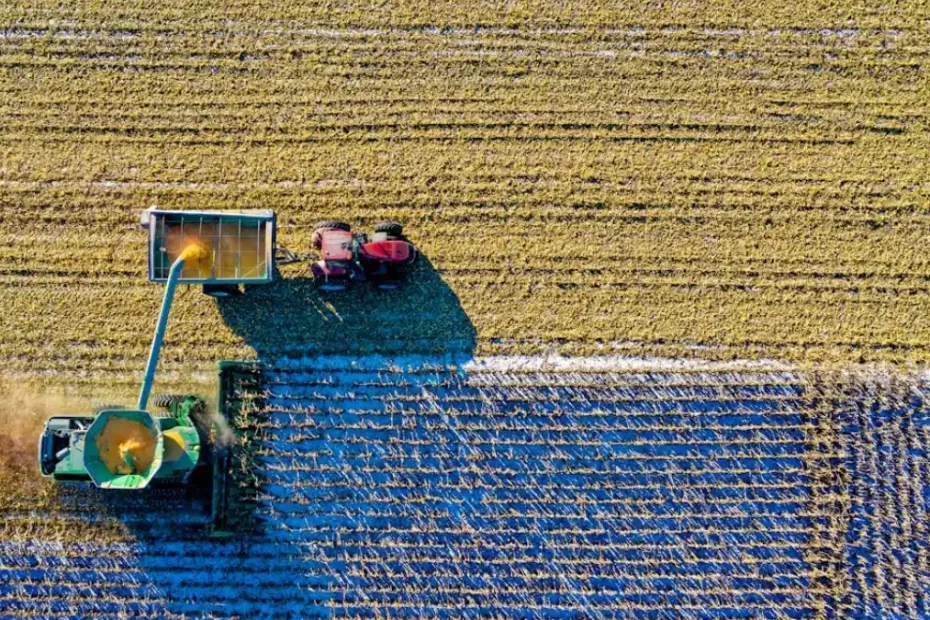The primary goal of this article is to provide a comprehensive guide to farm loans in Australia.
Whether you are a farmer looking to expand your operations or seeking financial support for specific agricultural projects, this resource offers detailed insights into various loan options, eligibility criteria, and the application process.
Loans
Comprehensive Guide to Green Loans in Australia
Green Loans provide a sustainable way to finance projects that reduce environmental impact while offering competitive financing options
You will continue on our website
By covering essential information, including the benefits, risks, and necessary documentation, this guide aims to empower readers with the knowledge needed to make informed financial decisions for their agricultural businesses.
What Are Farm Loans?
Farm loans are financial products specifically designed to provide funding for agricultural businesses and farming operations. These loans help farmers cover expenses related to land acquisition, equipment purchases, livestock management, crop cultivation, and other operational costs.
Unlike traditional loans, farm loans are tailored to the unique needs of the agricultural sector, offering flexible repayment terms and interest rates that account for the seasonal nature of farming.
Whether secured or unsecured, farm loans play a crucial role in enabling farmers to sustain and grow their businesses by providing the necessary capital to meet their specific needs.
Benefits and Considerations of Farm Loans
Farm loans offer numerous advantages for agricultural businesses looking to expand or maintain operations. One of the primary benefits is access to capital, allowing farmers to invest in essential resources such as land, equipment, livestock, and infrastructure.
Additionally, farm loans provide flexibility with tailored repayment terms that accommodate the cyclical nature of farming income, making it easier to manage cash flow during peak and off-peak seasons.
However, it’s important to consider the potential challenges associated with farm loans. Interest rates may be higher compared to traditional personal loans, especially for unsecured options.
Additionally, securing collateral for loans can pose risks if repayments are not met, potentially leading to loss of assets. Thorough research and understanding of loan terms are essential to ensure that the benefits outweigh the risks, providing sustainable financial support for farming ventures.
Key Requirements and Documents Needed for Farm Loans
To apply for a farm loan, you will typically need:
- A comprehensive business plan
- Proof of land ownership or lease agreements
- Financial statements (e.g., balance sheets, profit and loss statements)
- Tax returns for the past two years
- Identification documents (e.g., driver’s license, passport)
- Cash flow projections and operational forecasts
Types of Farm Loans Available in Australia
1. Secured Farm Loans
Secured farm loans are backed by collateral—usually property, equipment, or livestock. These loans typically offer lower interest rates and longer repayment terms, providing a more flexible financing option for large agricultural investments.
Advantages: Lower interest rates, higher loan amounts, and longer repayment periods.
Disadvantages: Risk of losing collateral if loan repayments are not made.
2. Unsecured Farm Loans
Unsecured loans don’t require collateral, making them ideal for small to medium-sized agricultural operations. However, interest rates tend to be higher due to the increased risk for lenders.
Advantages: No need for collateral, faster approval process.
Disadvantages: Higher interest rates, lower loan amounts.
3. Farm Line of Credit
A farm line of credit provides ongoing access to funds that can be drawn as needed, similar to a credit card. It’s useful for managing seasonal cash flow and short-term expenses.
Advantages: Flexible, accessible funds for short-term needs.
Disadvantages: High interest rates, limited repayment options.
Top Banks Offering Farm Loans in Australia
1. NAB – National Australia Bank
NAB offers a variety of tailored farm loan solutions, including both secured and unsecured options. Their loans are flexible, with long-term repayment options and competitive interest rates.
Key Features:
- Loan amounts up to $10 million
- Repayment periods up to 30 years
- Dedicated agricultural specialists to guide through the process
2. Westpac
Westpac provides a wide range of farm loans designed to meet diverse farming needs, from crop cultivation to livestock management.
Key Features:
- Seasonal repayment schedules
- Options for refinancing existing farm debt
- Expertise in sustainable agricultural practices
3. Commonwealth Bank
Commonwealth Bank offers comprehensive farm finance solutions with a focus on innovation and sustainability. They provide a wide range of tailored financial products for farms of all sizes.
Key Features:
- Green farming initiatives
- Fast online application process
- Support for agri-tech adoption and modernization
Step-by-Step Process for Applying for a Farm Loan
Step 1: Prepare Your Financial Documents
Gather necessary documents such as business plans, financial statements, tax returns, and any other required documentation.
Step 2: Assess Loan Options
Compare different farm loan options based on interest rates, repayment terms, and eligibility criteria.
Step 3: Submit Your Application
Apply online or visit the bank in person. Ensure all required information is provided accurately.
Step 4: Approval and Documentation
Once approved, review the loan terms carefully and sign the necessary paperwork.
Step 5: Manage Your Loan
Regularly monitor repayments and use the funds according to the agreed-upon terms.
Common FAQs About Farm Loans
1. What are farm loans and how do they work?
Farm loans are financial products designed to provide funding for agricultural businesses, including purchasing land, equipment, livestock, and managing operational expenses. These loans can be secured or unsecured, offering tailored terms based on the borrower’s specific needs.
2. What types of farm loans are available in Australia?
There are several types of farm loans available, including secured farm loans, unsecured farm loans, and farm lines of credit. Each type caters to different farming needs, from large investments to short-term working capital.
3. What are the eligibility criteria for farm loans?
Eligibility for farm loans typically includes factors such as the size and scope of the farming operation, financial stability, business plans, and credit history. Lenders may also require a certain level of collateral for secured loans.
4. What documents do I need to apply for a farm loan?
To apply for a farm loan, you will generally need financial statements, tax returns, a detailed business plan, proof of land ownership or lease agreements, and identification documents.
5. How do I choose the right farm loan for my needs?
Choosing the right farm loan involves assessing factors such as loan purpose, repayment terms, interest rates, and whether you need secured or unsecured options. Consider your long-term business goals and seasonal cash flow when selecting a loan.
6. What factors should I consider when selecting a farm loan?
When selecting a farm loan, key factors to consider include interest rates, repayment flexibility, loan terms, the reputation of the lender, and available support services. Additionally, you should evaluate the risks associated with taking out the loan.
7. What is the difference between secured and unsecured farm loans?
Secured farm loans require collateral (e.g., property, equipment), offering lower interest rates and longer repayment terms. Unsecured loans, on the other hand, do not require collateral but may come with higher interest rates and lower borrowing limits.
8. How do interest rates affect farm loan options?
Interest rates directly impact the cost of borrowing. Lower rates mean less repayment in the long run, while higher rates increase overall expenses. Comparing different lenders will help you find competitive rates.
9. What are the steps to apply for a farm loan in Australia?
The process generally includes gathering necessary documentation, choosing a loan type, submitting an application, and receiving approval. After approval, review and sign loan terms before disbursing the funds.
10. What is the application process for farm loans?
The application process typically involves submitting required documents, financial assessments, and a business proposal. Lenders assess these and provide feedback regarding loan approval.
11. How long does it take to get approved for a farm loan?
Approval timelines vary, depending on the complexity of the application and the lender. Generally, it can take anywhere from a few weeks to a few months.
12. Are there any grants or subsidies available for farm loan applicants?
Yes, there are various grants and subsidies available for farmers, such as government support programs for sustainable farming, disaster recovery, and innovation in agriculture. These can be explored alongside traditional loan options.
13. What are the risks and challenges of taking out a farm loan?
Risks include fluctuating agricultural markets, interest rate changes, and the inability to meet repayment schedules. Proper financial planning and risk management are essential to mitigate these challenges.
14. What happens if I can’t repay my farm loan?
If repayments become difficult, lenders may offer alternative solutions, such as restructuring loans or extending repayment periods. In severe cases, failure to repay may lead to loss of collateral.
15. How can I manage the financial risks associated with farm loans?
Managing risks involves maintaining accurate financial records, diversifying income sources, and ensuring a stable business plan that aligns with market conditions.
16. What should I do if my farm business is not generating enough income to cover loan repayments?
Review financial practices, explore additional revenue streams, and seek guidance from agricultural financial advisors to improve the financial stability of your farm business.
17. How can I improve my chances of loan approval?
To enhance your chances, provide a clear, well-documented business plan, maintain a healthy credit history, and ensure all financial statements are accurate and up to date.
18. What financial documents do lenders look at during the assessment process?
Lenders review financial statements, tax returns, profit and loss statements, cash flow projections, and business plans to evaluate the viability of your farm business.
19. How can I demonstrate the viability of my farm business to lenders?
You can demonstrate viability by providing a solid business plan, past financial performance, growth forecasts, and detailed operational insights.
20. Are there any support services available to guide me through the farm loan application process?
Yes, agricultural financial advisors and specialized farm loan specialists can offer tailored advice and guide you through the application process to ensure a smooth experience.
Conclusion
Farm loans are a valuable financial tool for farmers and agricultural businesses seeking to grow and sustain their operations. By offering tailored solutions that address the unique needs of the agricultural sector, these loans provide the necessary support for purchasing land, equipment, and managing operational expenses.
Loans
Debt Consolidation Loan: A Complete Guide for Australians
A Debt Consolidation Loan allows you to combine multiple debts into a single loan with a fixed monthly payment
You will continue on our website
Understanding the different types of farm loans, their benefits, and potential challenges is crucial for making informed financial decisions. Whether you’re looking for a secured loan, an unsecured option, or a line of credit, careful consideration of terms, eligibility requirements, and documentation is essential.
For further assistance and to explore your loan options, it’s recommended to consult with financial experts or directly engage with reputable lenders through their official channels. This ensures a smooth and transparent loan application process tailored to your specific farming needs.

